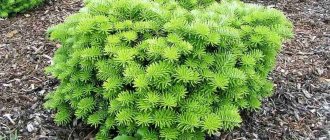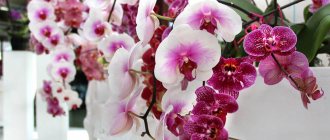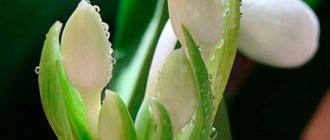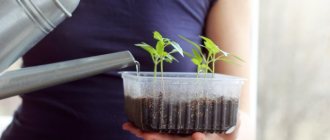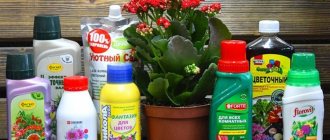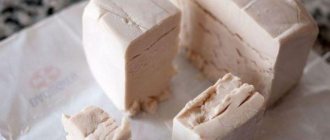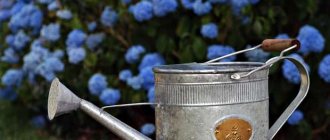Distinctive feature of the Master series
All cultivated plants require additional nutrition during the growing season.
I will tell you what fertilizers I use, and for this purpose I specially came to the store where I buy Master fertilizers from the Valagro company, although you can choose for yourself, for example, Polifit or Terraflex fertilizer.
I prefer Master fertilizers because I tested their effect on my plants, and the preparations in this series are conveniently distinguished by color.
- Potatoes: treatment before planting
- Fertilizer with the formula 18:18:18 (nitrogen:phosphorus:potassium) is white, a substance with the composition 15:5:30 plus magnesium is light pink.
- Fertilizer with the formula 20:20:20, which does not contain magnesium, but which contains other microelements - turquoise.
- Fertilizer with the formula 3:11:38 plus magnesium cream.
It is not worth treating plants leaf by leaf with Master preparations, because phosphorus and potassium will be poorly absorbed, while the fertilizer from Polifit contains nitrogen in the amide form, which is perfectly absorbed in foliar fertilizers.
Norms for the use of nitrogen fertilizers
Nitrogen fertilizing helps increase the productivity of absolutely all garden crops. Most often, gardeners use a common fertilizer:
- for the growth and development of vegetables (potatoes, tomatoes, cabbage, peppers, beets);
- to increase the yield of berry crops (strawberries, strawberries);
- for feeding shrubs and fruit trees;
- for caring for ornamental plants and flowers;
- for lawn maintenance;
- when planting seedlings.
All members of the legume family (peas, soybeans, asparagus) require less nutritional supplements.
The average dosage of fertilizer used for flower and vegetable crops is 0.5 kg of nitrogen for every 100 square meters of cultivated area.
Depending on the method of use, the dosage of the starting substance is slightly different:
- when used in dry form, only 200 g of nitrogen per 100 square meters is needed; To make a nutrient solution, you need to dilute 30 g of the active substance in a bucket of water.
Potassium monophosphate
At the initial stage, I usually use a rooting agent with a high phosphorus content, but it is not on sale now. If I cannot find a rooting agent, I will use monopotassium phosphate with the formula 0-52-34 for this purpose, that is, there is no nitrogen in this preparation at all. I purposely name the formulas to make it easier for you to navigate.
By watering seedlings with monophosphate at the initial stage, you will promote their active rooting, but will avoid the excessive development of the vegetative mass: your seedlings will not stretch. And although monophosphate does not contain the main rooting substance - succinic acid, you can always add it.
To prepare 10 liters of solution you will need 20-25 g of potassium monophosphate and 2 g of succinic acid.
Adding potassium
During the fruiting stage, plants need potassium most of all, and you can feed them at the end of the growing season with the same monopotassium phosphate or, to enhance the effect, with pure potassium.
- Ammonium nitrate: use in the garden
I am not a supporter of overfeeding plants with fertilizers, so with drip irrigation I use 1 g of potassium per plant, although other gardeners add 2-3 g of this substance under each root. But I’d rather add potassium several times in small doses than add the entire amount the plant needs at one time.
If you do not have a drip irrigation system, you can add potassium solution under the plants, maintaining a concentration of 20-25 g of the element per 10 liters of water, but it is better to dilute 10 g of potassium in 10 liters of water and water the plants with this solution twice with an interval of 3 days .
Now about the order in which fertilizing should follow. The first feeding, as we have already found out, will be done with potassium monophosphate (potassium and phosphorus) with the addition of succinic acid, and after about a week you need to add Calcinite, that is, calcium and nitrogen. Potassium supplements will be needed during the fruiting period.
Folk remedies for caring for seedlings
It is important to understand that sometimes the growth of seedlings can practically stop, and the reason for this will be the lack of the simplest but most important microelements, which have nothing to do with nitrogen. To restore the balance of nutrients, it is not at all necessary to buy expensive complex fertilizers. Sometimes it is enough to use ordinary household waste.
- Eggshell. The powder of the marked ingredient is combined with organic compost and added to the ground before planting the seeds. Another option is egg infusion: the shells are filled with water (1:20) and sent to “marinate” in a warm place for several days. The resulting composition is rich in valuable vitamins and minerals, so it can be used to treat the soil before planting seedlings.
- Banana peel. An excellent product for making healthy mulch. The crushed remains of the dried fruit shell are used as an effective fertilizer. For greater effectiveness, they can be combined with coffee grounds.
- Yeast. Plants will grow and develop more actively if they are treated with yeast infusion. To do this, you will have to mix a few grams of the active ingredient with 100 g of sugar and 3 liters of water. The resulting starter should ferment for at least a week. The finished mash remains to be diluted in warm water and treated with it on the grown shoots.
- Meat or fish slops. As disgusting as it may sound, the water where raw meat or fresh fish was washed is considered an excellent fertilizer for most vegetable crops.
- Onion peel. A solution is prepared from it that helps protect the bushes from many diseases and pests. All you need to do is boil a handful of husks in a couple of liters of water, cool the resulting mixture and dilute it with a small amount of clean water. Suitable for processing only sprouted crops while they are still standing on the windowsill.
Why do manufacturers indicate the formula on drugs?
On any drug, manufacturers indicate its formula, that is, the amount of macroelements it contains. In the first place in the formula is the amount of nitrogen, which is responsible for the green mass, in the second place is the amount of phosphorus, which stimulates the development of the root system, and in the third place is the content of potassium, which is responsible for flowering and fruit filling.
For example, if the formula of the drug is 3-11-38 + 4 magnesium, this means that there is little nitrogen in the drug, a moderate amount of phosphorus, and a lot of potassium. This composition is suitable for application at the last stage of the growing season: potassium will help the plant remove amino acids and sugars formed as a result of photosynthesis from the leaf blades into the fruit. The effect of nitrogen on the leaf and stem mass will be insignificant, the plant always needs phosphorus, and magnesium will have a positive effect on the sweetness of the fruit.
Fertilizer with the formula 20:20:20 is universal: it can be used throughout the entire growing season, applied at the roots of plants every 10 days, but it is still better to do the first fertilizing with potassium monophosphate, and then, when the plants develop a root system and leaves, stem mass and the laying of generative organs - buds or inflorescences - will begin, you can switch to fertilizer with the formula 20:20:20 or 18:18:18.
The drug with the formula 15:5:30 is best used when the process of fruit formation is in full swing or flowering crops begin to bloom, but the above-ground part of the plant is not sufficiently developed. Then the plants will greatly benefit from nitrogen, which stimulates the development of stems and leaves, and potassium, which supports flowering and fruiting. And phosphorus, as you already know, the plant always needs.
- Red clover: cultivation, properties, varieties
Mandatory feeding for petunia
If you learn how to properly fertilize petunia and know exactly what to feed these flowers with, you can achieve long and colorful flowering. So, petunia is fertilized with potassium monophosphate so that the buds have a brighter color.
The first thing a grower needs to consider is what important minerals and trace elements the crop needs.
The first feeding for petunia is applied by spraying the leaves two weeks after the sprouts emerge. To do this, seedlings are shed with a weak solution of manganese or fungicides. It is necessary to spray the plants so that the solution gets on the stems and leaves, as well as on the ground.
The soil in the box with seedlings should be kept moist at all times. But petunia should not be over-watered, as excessive dampness can cause root rot.
Petunia seedlings will grow very well if you regularly fertilize them with mineral mixtures. Typically, fertilizing with mineral supplements is carried out between watering the plants. It is enough to add minerals once every two weeks.
Fertilizers for foliar feeding
As for foliar feeding, it cannot replace root feeding in terms of effectiveness, but at some stages it is very useful.
For leaf feeding, special fertilizers are used, for example, a preparation from Plantafol, which contains nitrogen in amide form, which helps all other elements included in the fertilizer to be quickly absorbed by the plant.
The composition with the formula 5:15:45 is also best applied one leaf at a time once every 10 days at the beginning of fruit formation and during the fruiting process. It contains both macro and microelements. If the plants have enough macroelements, you can use Brexil Combi for spraying, which does not contain nitrogen, phosphorus and potassium, but contains a whole set of microelements. This company also produces mono-drugs: Brexil iron, Brexil zinc and so on.
For good rooting of seedlings, you may need Radifarm (25 g per 10 liters of water).
Feeding stages for good growth
At each stage of growth, petunia seedlings must be fed with different preparations:
First feeding
It occurs at the stage of formation of 3-4 true leaves. At this time, it is important to carry out preventive treatment against various pathogenic microorganisms so that young plants do not get sick, and at the same time their growth improves. For this, potassium permanganate or a solution of phytosporin and energen are best suited. It is better to water with preparations using a sprayer, so they can evenly cover the soil and the upper part of the stems without injuring the roots.
Before the pick
At this time, plants are fertilized as needed, paying attention to their appearance. If the plants have stopped growing and look stunted and yellowed, they are probably lacking nutrients. Chlorosis of the lower leaves often occurs due to nitrogen deficiency. In this case, nitrogen fertilizers are used.
You can also use complex mineral supplements, which also contain potassium, phosphorus and other microelements. On the eve of picking, seedlings are treated with zircon to boost their immunity.
After the pick
Maintain an interval of 7-9 days and fertilize with calcium nitrate, adding 1 teaspoon of the drug to 1 liter of water. Fertilizer will promote better nitrogen absorption, accelerate photosynthesis, and help resist various rots.
After another week, the fourth feeding is carried out . At this stage it is necessary to add nitrogen complexes. The best fertilizers during this period will be “Effecton”, “Uniflor micro”, “Kemira”, “Kristalon”, “Uniflor Rost”, “Plantafol”.
During these periods, fertilization is mandatory. But do not try to fertilize petunia seedlings too often. Excess minerals can also be harmful.
To fertilize or not to fertilize
I will definitely tell you how to apply fertilizers as my seedlings grow, but you must understand that the amount of fertilizing and dosage depend on the type of soil, acidity, fertility of your soil, as well as on what fertilizers and in what quantities you added to the soil. soil earlier.
Some of the previously applied fertilizers were absorbed by your plants, some evaporated or were washed away by watering and rain, but some of them probably remained in the soil, so you need to monitor the development of plants, their condition and apply fertilizers only as needed, taking into account that in each climate at the same time different temperatures and different solar activity.
I wish you to take your time to sort everything out and purchase in advance the fertilizers you will need next season.
All the best to you.
The seedlings have outgrown and died
A common problem is that petunia seedlings are already ready to be planted in the ground, but the temperature outside is still below freezing. By the time the last frosts pass and consistently warm weather prevails, the seedlings will have time to greatly outgrow, and the stems will droop from the weight of the leaves and buds. In such conditions, the lower leaves will begin to turn yellow, and there will be a risk of developing fungal and bacterial diseases.
Attention! The last time petunia is planted in containers of 200–250 ml, this volume is enough for seedlings no older than 2.5 months. In adult seedlings with long stems, the needs increase, the roots require a larger area of nutrition, and in old containers the plants weaken greatly.
They don’t wait for warm weather; the main stems of the seedlings and side branches are cut off by a third of the length, leaving the same feeding regime. If this is not done, the stems will become thin and weak; overgrown bushes will take a long time to take root after transplantation and will bloom only at the end of summer. After pruning, petunias will quickly recover, become lush and stocky, and their immunity will increase.
